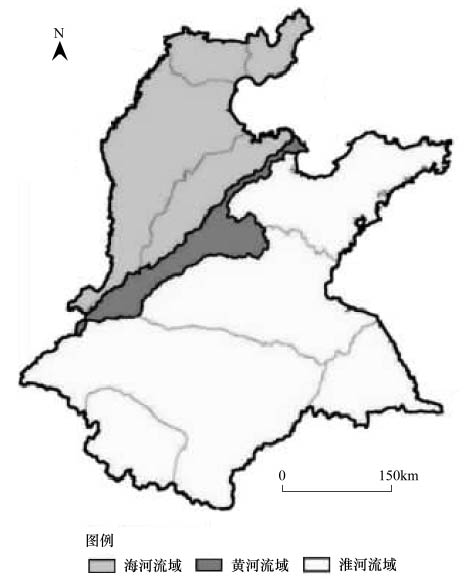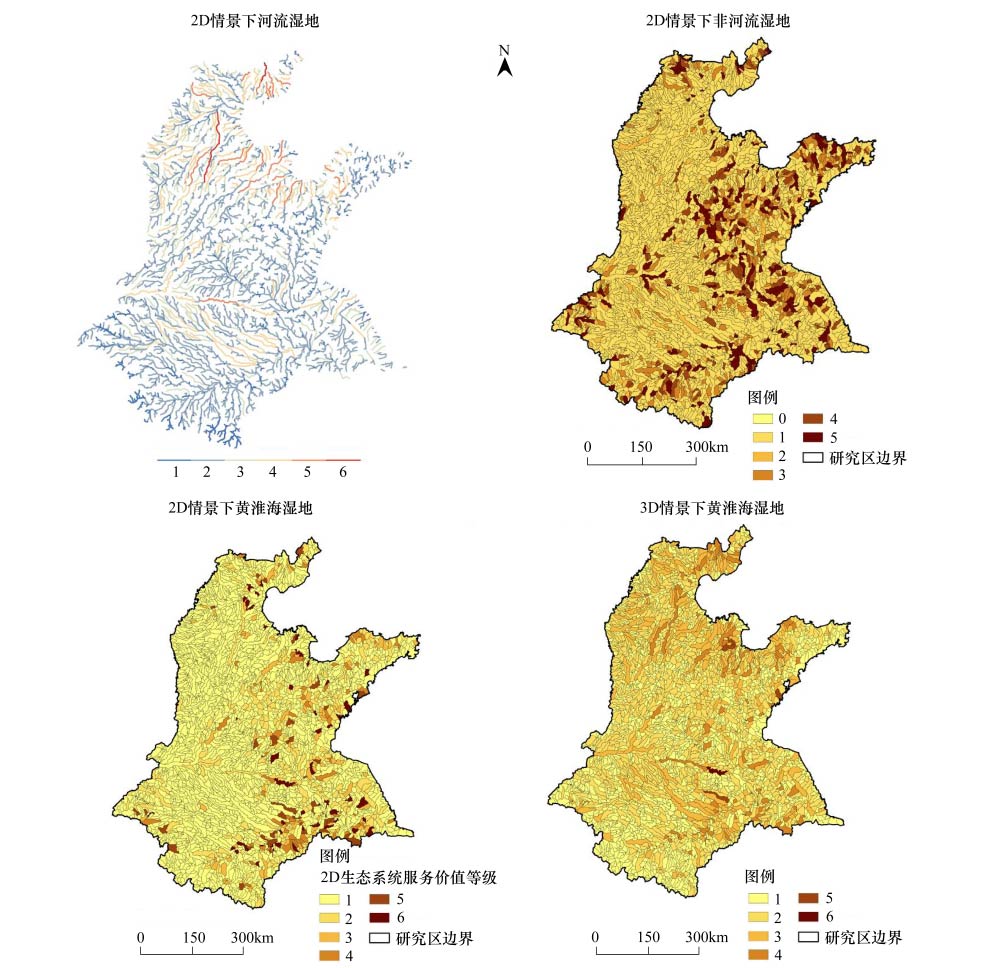文章信息
- 张黎娜, 李晓文, 宋晓龙, 梁晨, 诸葛海锦
- ZHANG Lina, LI Xiaowen, SONG Xiaolong, LIANG Chen, ZHUGE Haijin
- 黄淮海湿地生态系统服务与生物多样性保护格局的耦合性
- Analysis of spatial congruence between ecosystem services and biodiversity in huanghuaihai region
- 生态学报, 2014, 34(14): 3987-3995
- Acta Ecologica Sinica, 2014, 34(14): 3987-3995
- http://dx.doi.org/10.5846/stxb201103180338
-
文章历史
- 收稿日期:2011-3-18
- 修订日期:2014-5-12
2. 农业部环境保护科研监测所, 天津 300191
2. Agro-Environmental Protection Institute, Ministry of Agriculture, Tianjin 300191, China
自从《千年生态系统评估》[1]提出生态系统服务对自然系统可持续发展的重要支撑作用以来,生态系统服务功能就被作为保护生物多样性和检验生物多样性保护有效性的依据[2]。最近几年来,有关生态系统服务与生物多样性之间联系的研究越来越多。一些学者的研究认为二者的持续性之间存在着联系[3, 4, 5],但关于生物多样性与生态系统服务功能耦合性如何,生物多样性保护在多大程度上满足了生态系统服务功能的支撑和维护的争议,由于目前研究水平和进展的限制,成为本领域内的一大研究热点。大多数保护区的设立基于对生物多样性的保护,缺乏生态系统服务功能的保护理念,通过案例研究去揭示生物多样性保护格局对不同类型生态系统服务功能的支撑作用,以及二者之间的协调机制,具有重要的理论和实践意义,并已引起国际上的高度关注[6, 7, 8, 9, 10, 11, 12]。
国内外关于生态系统服务功能的研究多集中于陆域生态系统[13, 14, 15, 16, 17, 18, 19],其方法难以适用于湿地生态系统,而且以往对湿地生态系统服务功能研究多集中于分析湖泊、沼泽、滨海等非河流湿地类型[20, 21, 22, 23, 24, 25]的生态健康、娱乐功能、供水等方面的服务功能[26, 27, 28],未对整合所有湿地类型的湿地生态系统(既包括河流湿地生态系统,也包括其他非河流湿地生态系统)服务功能进行深入分析,建成湿地生态系统服务功能的综合性评估体系,更缺乏对生态系统服务与生物多样性的空间相关分析。
本研究采用河流湿地生态系统服务功能与非河流湿地生态系统服务功能的综合评估方法,并借鉴保护生物学相关理论方法,对黄淮海区域进行宏观尺度的湿地生态系统服务功能空间分布研究,找出重要生态系统服务功能区,进一步对生态系统服务功能和生物多样性进行空间相关性分析,进行生态系统服务功能与生物多样性空间耦合性,从而分析现有保护区对生态系统服务功能的支持程度。本研究一方面可以为生态系统服务功能评价和生物多样性保护研究提供理论和方法基础,同时对三维连接性的考虑也可以为日后的湿地生态系统服务功能评价提供借鉴。
1 研究区概况黄淮海地区按照全国水资源分级分区7个省市,面积48.4万km2,分布区位见图 1。该地区具有多种湿地类型,作为东亚地区候鸟迁飞路线上的重要停歇地和中转站,其生物多样性丰富[29]。同时该地区聚集着全国重要的石油化工、盐化工基地和钢铁基地,港口,以及密集的交通和物流中心,属于典型的高强度开发海岸带[30]。持续高强度的开发建设使区域湿地的性质和分布格局发生了根本性的变化,表现为自然湿地被侵占、割裂,滨海湿地性质发生改变,湿地退化过程不断加剧,区域可持续发展能力以及生态安全受到威胁。为保护生物多样性,目前已建有52处省级以上保护区,面积约17113 km2,但基于生物多样性的保护区能否为该地区的生态服务功能提供支撑?结合黄淮海地区生态系统服务功能分布格局的空间研究,如何在同一时空条件下最大限度保护生物多样性和生态系统服务功能,已成为该区域可持续发展长期面临的关键问题。

|
| 图 1 黄淮海地区地理位置 Fig. 1 Geographical location of Huang-Huai-Hai Region in China |
本研究采用的数据主要有:90m分辨率DEM数据,1 ∶ 25万数字水系图,湿地保护区分布(截止2008年底),湿地分布(2000年),土地利用类型分布数据(2000年),土壤分布图(2000年)、中国年平均降雨图,地貌数据(2000年),南水北调东中线,黄淮海地区地下水分布数据,全国县域行政区划图,基于以上基础数据建立地理信息系统数据库。其中DEM空间数据是采用了由WWF开发的基础水文数据-HydroSheds;湿地保护区分布数据主要来源于当地管理部门、参考文献和专家知识;湿地分布数据来源于中国科学院遥感应用研究所;土地利用类型分布数据、土壤数据、地貌数据来源于中国科学院地理科学与资源研究所;1 ∶ 25万水系数据和全国县域行政区划数据主要来源于国家基础地理信息中心;中国土壤数据与中国降雨年平均降雨图数据来自于中国科学院科学数据库,地下水数据来源于中国地质科学院水文地质环境地质研究所。
本研究选用国际保护学界广泛认同的集水区作为评价单元[31],结合湿地分布数据,将黄淮海地区湿地系统分为河流湿地和非河流湿地,其中非河流湿地分为湖库、沼泽和滨海湿地。
2.2 研究方法湿地系统有明显的多维连接性,即横向连接性、纵向连接性和垂向连接性。横向连接性主要是指河流主干与其支流,以及各湿地类型通过河流湿地相互关联所形成的关系;纵向连接性主要是指河流湿地上下游之间的连接性及上游保护对下游保护的传递效应,目前的研究也多关注此二者,即2D连接性。湿地系统中地表水系及其相关的生物多样性也与地表-地下间的水文联系相关,即湿地的垂向连接性[27]。因此,结合垂向连接性的三维连接性(3D)对湿地生态系统研究更具实际意义。本文基于2D和3D连接性分别分析了黄淮海地区湿地生态系统服务功能与生物多样性的空间耦合性,从而更加全面反映二者的关系。
2.2.1 黄淮海湿地生态系统服务功能空间格局分析根据河流湿地和非河流湿地不同的状态特点,分别采用不同方法评价生态系统服务功能,而后进行综合空间叠加分析,得出基于2D连接性的综合性湿地生态系统服务功能空间分布状态。此外,考虑到垂向维度地下水对湿地生态系统服务功能的贡献,评估了基于3D连接性的湿地生态系统服务功能分布状况。
(1)河流湿地生态系统服务功能评估方法
河流湿地生态系统服务功能基于横向和纵向连接性(2D连接性)选取径流及河网密度为参数进行评价,方法见文献[32],评估公式如下:

式中,ESr为河流湿地生态系统服务功能价值,Sro为径流量贡献的生态系统服务功能价值,Srd为河网密度的生态系统服务功能价值,n为河流湿地生态系统集水单元数,α、β为叠加比例。
(2)非河流湿地生态系统服务功能评估方法
本文在Costanza 等人提出的生态系统服务功能类型基础上[33],根据我国黄淮海地区湿地生态系统特征[34],选择了一系列相关生态系统服务功能(表 1),参照相关文献中不同生态系统服务功能评估方法[12, 24, 35, 36],分别对不同类型非河流湿地的不同生态系统服务功能估算。非河流湿地生态系统服务功能评估公式如下:

式中,ESi是第i个集水区单元的非河流生态系统服务功能;Aij为第i个集水区单元内第j种湿地类型的面积;Sj是单位面积的第j类湿地生态系统服务功能价值(表 1);m为非河流湿地生态系统集水单元数;αj是第j种湿地类型的叠加比例。
| 非河流湿地 Non-river wetland | 调蓄 Regulation | 贮水 Storage | 土壤形成 Soil formation | 水质净化 Water Purification | 生产 Production | 生境 Habitat | 固碳 Carbon sequestration | 文化娱乐 Culture and entertainment |
| “√”表示“有” | ||||||||
| 湖库 Lakes and reservoirs | √ | √ | √ | √ | √ | √ | ||
| 淡水沼泽 Freshwater marshes | √ | √ | √ | |||||
| 滨海湿地 Coastal Wetlands | √ | √ | √ | |||||
基于2D连接性的生态系统服务功能计算为仅考虑河流横向和纵向连接性,而基于3D连接性的生态系统服务功能体现在将地下水的储量和分布纳入各个服务功能的估算中。评估黄淮海地区基于2D和3D不同情景下的湿地生态系统服务功能,按照聚类分析分为6级,以4—6级作为重要服务功能区。
2.2.2 生态系统服务功能与生物多样性保护格局的耦合分析现有保护区格局分别于2D、3D情景下获取的生态系统服务功能区进行叠加分析,得出保护区对生态系统服务价值高值区的重合程度。而后进行生态系统服务功能与生物多样性保护格局的T检验,以定量化分析二者的耦合关系。将已有保护区分布分别与2D情景下的整个研究区重要生态系统服务功能流域单元、河流湿地系统服务功能以及非河流湿地生态系统服务功能进行了基于同一空间位置及其相应空间属性的配对T检验;并且将3D的生态系统服务功能重要区域分别与现有保护区、之前的2D生态系统服务功能重要区域、基于3D连接性的湿地系统保护优化方案[34]的优先保护区域采用配对T检验,以检验二者是否在空间保持一致性。
3 结果 3.1 黄淮海湿地生态系统服务功能空间格局黄淮海地区湿地类型多样,滨海滩涂湿地、淡水沼泽湿地、河流湿地、湖泊湿地、河口湿地、沼泽化草甸等的天然湿地系统相互关联、耦合,同时由于浅层地下水是黄淮海平原水资源中的重要组成部分,因而具有独特的湿地系统类型,尤其是其垂向连接性的地下水分布需要格外关注。
黄淮海地区湿地生态系统服务功能的空间格局如图 2所示,2D情景下,河流生态系统中主干河道生态系统服务价值较高,可以看出河流生态系统服务重要区域在滨海区域相对集中。非河流湿地生态系统服务价值在黄河流域中下游地区及淮河流域较为集中,此外淮河的南部及西南部和海河地区北部也出现生态服务功能价值较高地区。就目前不同等级的生态系统服务面积来看,4—6较高等级湿地面积所占比重为5.2%,共有91个流域单元,占总流域单元数量的3%,河流生态系统服务对总系统服务功能贡献较大(图 2)。

|
| 图 2 黄淮海湿地生态系统服务功能空间格局 Fig. 2 The spatial pattern of ecosystem services in Huanghuaihai region a: 2D情景下河流湿地River wetlands based on 2D, b: 2D情景下非河流湿地Nonriver welands based on 2D, c: 2D情景下黄淮海湿地Huanghuaihai region wetlands based on 2D, d: 3D情景下黄淮海湿地Huanghuaihai region wetlands based on 3D |
3D情景下,考虑总体生态服务功能,在环渤海区的滨海地区及河流主河道生态服务价值较高,与2D情形有所重叠但不相同,4—6级功能价值较高的湿地(图 2)共有156个流域单元,占总流域单元数量的4.8%,高于2D条件下的92个流域单元。
3.2 黄淮海湿地生态系统服务价值与生物多样性保护空间耦合性评估保护区的建立多以生物多样性保护为目的,其设立范围也多为生物多样性典型区域。为了实现生态系统服务功能和生物多样性的耦合性特征辨识,依据黄淮海现有保护区[34]对生态系统服务功能保护的贡献程度,对二者空间格局进行相关性分析。
3.2.1 基于叠加分析的耦合分析在2D情景下,保护区系统最高的生态系统服务等级仅为4级,且只占有14个流域单元。保护区所在的157个集水单元中,大多数湿地生态系统服务功能仅为3级单元。现有保护区没有对5、6等高等级湿地生态系统服务关键区域起到保护作用。显然,黄淮海区域存在很多湿地生态系统服务关键格局的保护空缺和支撑盲点。
而在3D情景下,研究区内所有保护区的最高生态系统服务等级达到5级,8个流域单元,占保护区270个集水区单元的2.96%,而其他保护区内流域单元大多数仅到达2级。相对于2D情形下的生态系统服务功能保护情况有所提高,但对于关键的生态系统服务关键格局特别是对5、6级的生态系统服务区域的保护仍需进一步加强和完善。
3.2.2 基于T检验的耦合分析通过基于空间配对的T检验对2D情景下河流/非河流湿地及其湿地总体生态系统服务格局与现有保护区的空间一致性进行了分析(表 2,图 4),结果表明:现有湿地保护格局与河流湿地、非河流湿地以及湿地综合生态系统服务关键格局均存在显著性差异,而其中河流湿地生态系统服务格局与保护格局差异更为显著,可见现有以保护生物多样性为目的的保护区网络并不能充分维护湿地系统总体生态系统服务功能的发挥,特别是河流湿地生态系统服务关键格局保护应格外重视。

|
| 图 3 黄淮海地区湿地生态系统服务功能等级与保护区分布空间对照 Fig. 3 The spatial distribution contrast between ecosystem services grade and biodiversity protection in Huanghuaihai region |

|
| 图 4 生物多样性保护与生态系统服务功能的比例分析 Fig. 4 The proportion of key ecosystem services region captured by biodiversity reserves |
| 配对T检验 Paired T test | ES_2D总值 ES_2D total value | 河流ES值 River wetlands ES value | 非河流ES值 Nonriver wetlands value |
| 保护区reserves | r=0.042; P=0.017 | r=0.021; P=0.233 | r=0.024; P=0.167 |
通过配对T检验,将3D(结合考虑地下水)的生态系统服务功能关键格局分别与现有保护区、基于3D连接性的湿地系统保护格局以及跨流域湿地系统保护综合格局进行空间耦合效应分析(表 3),表明优化后的保护格局对3D生态系统服务功能格局的保护水平(r=0.130;P=0.000)有所提高。但是,基于不同策略湿地保护关键格局与生态系统服务功能关键格局仍存在显著性差异(r=0.036; P=0.040)。
| 配对T检验 Paired T test | 现有保护区 Exiting reserves | ES_2D总值 ES_2D total value | 3D_生物多样性优先保护区 3D_biodiversity priority areas |
| ES_3D总值 ES_3D total value | r=0.183; P=0.000 | r=0.530; P=0.000 | r=0.111; P=0.000 |
(1)黄淮海地区已建保护区未能有效覆盖湿地生态系统关键区域[34],湿地生态系统服务关键格局也存在明显的保护空缺。以物种保护为主要目标的湿地系统保护格局和保护规划难以满足、契合对湿地生态系统服务格局保护的需求,二者在空间上存在明显差异性,耦合性低。因此未来湿地保护应有物种生境导向进一步扩展至对生态系统服务关键格局的保护。生态系统服务格局优化及其保护规划需要更具针对性的理论、方法指导。
(2)对河流湿地生态系统服务功能的评估方法研究,可以与非河流湿地生态系统服务功能整合,建立一套湿地生态系统服务功能综合性评估体系。由于河流湿地较湖库、沼泽、滨海等非河流湿地具有动态的特征,不容易建立保护区以持续支撑生态系统服务功能,因而对河流生态系统服务功能的评估及保护是湿地生态系统服务功能保护中这一空缺的有效补充。
(3)湿地系统的水文过程是湿地生态的关键因素,因而结合三维空间连接性的评估和探讨更具研究和实际意义。国外学者已经对包括了地下水分布的生物多样性做了系统保护规划的相关探讨,而本次研究中基于3D连接性的生态系统服务功能与现有的保护区耦合程度较2D情况下有所提高,表明在今后研究中地下水对于保护生物多样性和保护生态系统服务功能同样具有重要影响。
(4)系统保护规划方法对生态系统服务功能优化规划中的借鉴性意义。本文中的生态系统服务功能“热点地区”(重要区域),类似于保护生物学中所指的物种保护的热点地区[31, 32],而且随着2D到3D条件下,保护区对生态系统服务功能的支持程度发生变化,与系统保护规划中选择不同保护目标后格局发生变化的情况类似,这说明生态系统服务功能也可以借鉴保护生物学中系统保护规划的理论和方法[37, 38],为日后的深入研究提供基础。因而通过考虑社会经济因素,探索一定保护成本制约下,生态系统服务功能与生物多样性保护之间的协调模式将使会系统保护规划相关研究更具可行性和应用价值。这一点已经开始受到关注,但尚未并没有将二者的保护目标整合到一个统一的保护规划框架内,可以作为研究重点。
| [1] | Alcamo J, Bennet E M. Ecosystem and Human Well-Being: a Framework for Assessment (Millennium Ecosystem Assessment). Washington DC, USA: Island Press, 2003. |
| [2] | Chiesura A, de Groot R. Critical natural capital: a socio-cultural perspective. Ecological Economics, 2003, 44(2/3): 219-231. |
| [3] | Armsworth P R, Chan K M A, Daily G C, Ehrlich P R, Kremen C, Ricketts T H, Sanjayan M A. Ecosystem-service science and the way forward for conservation. Conservation Biology, 2007, 21(6): 1383-1384 |
| [4] | Naidoo R, Balmford A, Costanza R, Fisher B, Green R E, Lehner B, Malcolm T R, Ricketts T H. Global mapping of ecosystem services and conservation priorities. Proceedings of the National Academy of Sciences of the United States of America, 2008, 105(28): 9495-9500. |
| [5] | Singh S P. Balancing the approaches of environmental conservation by considering ecosystem service as well as biodiversity. Current Science, 2002, 82(11): 1331-1335. |
| [6] | Balvanera P, Pfisterer A B, Buchmann N, He J S, Nakashizuka T, Raffaelli D, Schmid B. Quantifying the evidence for biodiversity effects on ecosystem functioning and services. Ecology Letters, 2006, 9(10): 1146-1156. |
| [7] | Claire K, Richard S O. A call to ecologists: measuring, analyzing, and managing ecosystem services. Frontiers in Ecology and the Environment, 2005, 3(10): 540-548. |
| [8] | Van Jaarsveld A S, Biggs R, Scholes R, Bohensky E, Reyers B, Lynam T, Musvoto C, Fabricius C. Measuring conditions and trends in ecosystem services at multiple scales: the Southern African Millennium Ecosystem Assessment (SAfMA) experience. Philosophical Transactions-Royal Society. Biological Sciences, 2005, 360(1454): 425-441. |
| [9] | Whittaker R J, Arau' jo, M B, Jepson P, Ladle R, Watson J E M, Willis K J. Conservation biogeography: assessment and prospect. Diversity and Distribution, 2005, 11(1): 3-23. |
| [10] | Chan K M A, Shaw M R, Cameron D R, Underwood E C, Daily G C. Conservation planning for ecosystem services. Plos Biology, 2006, 4(11): e379. |
| [11] | Anderson B J, Armsworth P R, Eigenbrod F, Thomas C D, Gillings S, Heinemeyer A, Roy D B, Gaston K J. Spatial covariance between biodiversity and other ecosystem service priorities. Journal of Applied Ecology, 2009, 46(4): 888-896. |
| [12] | Turner W R, Brandon K, Brooks T M, Costanza R, da Fonseca G A B, Portela R. Global conservation of biodiversity and ecosystem services. BioScience, 2007, 57(10): 868-873. |
| [13] | Chazdon R L. Beyond deforestation: restoring forests and ecosystem services on degraded lands. Science, 2008, 320(5882): 1458-1460. |
| [14] | Malhi Y, Roberts J T, Betts R A, Killeen T J, Li W H, Nobre C A. Climate change, deforestation, and the fate of the Amazon. Science, 2008, 319(5860): 169-172. |
| [15] | Zhang W, Ricketts T H, Kremen C, Carney K, Swinton S M. Ecosystem services and dis-services to agriculture. Ecological Economics, 2007, 64(2): 253-260. |
| [16] | Sweeney B W, Bott T L, Jackson J K, Kaplan L A, Newbold J D, Standley L J, Hession W C, Horwitz R J. Riparian deforestation, stream narrowing, and loss of stream ecosystem services. Proceedings of the National Academy of Sciences, 2004, 101(39): 14132-14137. |
| [17] | Swift M J, Izac A M N, Van Noordwijk M. Biodiversity and ecosystem services in agricultural landscapes: are we asking the right questions? Agriculture, Ecosystems & Environment, 2004, 104(1): 113-134. |
| [18] | Nelson E, Mendoza G, Regetz J, Polasky S, TallisH, Cameron D, Chan K M, Daily G C, Goldstein J, Kareiva P M, Lonsdorf E, Naidoo R, Ricketts T H, Shaw M. Modeling multiple ecosystem services, biodiversity conservation, commodity production, and tradeoffs at landscape scales. Frontiers in Ecology and the Environment, 2009, 7(1): 4-11. |
| [19] | Lavorel S, Grigulis K, Lamarque P, Colace M P, Garden D, Girel J, Pellet G, Douzet R. Using plant functional traits to understand the landscape distribution of multiple ecosystem services. Journal of Ecology, 2011, 99(1): 135-147. |
| [20] | Worm B, Barbier E B, Beaumont N, Duffy J E, Folke C, Halpern B S, Jackson J B C, Lotze H K, Micheli F, Palumbi S R, Sala E, Selkoe K A, Stachowicz J J, Watson R. Impacts of biodiversity loss on ocean ecosystem services. Science, 2006, 314(5800): 787-790. |
| [21] | Hershner C, Havens K J. Managing invasive aquatic plants in a changing system: strategic consideration of ecosystem services. Conservation Biology, 2008, 22(3): 544-550. |
| [22] | Likens G E., Walker K F, Davies P E, Brookes J, Olley J, Young W J, Thoms M C, Lake P S, Gawne B, Davis J, Arthington A H, Thompson R, Oliver R L. Ecosystem science: toward a new paradigm for managing Australia's inland aquatic ecosystems. Marine and Freshwater Research, 2009, 60(3): 271-279. |
| [23] | Cui L J. Evaluation on functions of Poyang Lake ecosystem. Chinese Journal of Ecology, 2004, 23(4): 47-51. |
| [24] | Zhao T Q, Ouyang Z Y, Wang X K, Miao H, Wei Y C. Ecosystem services and their valuation of terrestrial surface water system in China. Journal of Natural Resources, 2003, 18(4): 443-452. |
| [25] | Gan F, Zhou Y J, Wei Q W, Fan E Y, Du H. Evaluation of the river ecosystem values of aquatic wildlife reserves: a case of Chinese Sturgeon natural reserve in Yichang reach of the Yangtze River. Journal of Natural Resources, 2010, 25(4): 574-584. |
| [26] | Lu C X, Xie G D, Cheng S K. Economic evaluation of river ecosystem service in recreation. Resources Science, 2001, 23(5): 77-81. |
| [27] | Sophocleous M. Interactions between groundwater and surface water: the state of the science. Hydrogeology Journal, 2002, 10(1): 52-67. |
| [28] | Ouyang Z Y, Zhao TQ, Wang X K, Miao H. Ecosystem services analyses and valuation of China terrestrial surface water system. Acta Ecologica Sinica, 2004, 24(10): 2091-2099. |
| [29] | Zhao Y M. Science Report of National Nature Reserve in the Delta of Yellow River. Beijing: Chinese Forestry Press, 1995. |
| [30] | Chen L K. Huangbohai Wetland and Migratory Waterfowl Research. Beijing: Chinese Forestry Press, 2006. |
| [31] | Wishart M J, Davies B R. Beyond catchment considerations in the conservation of lotic biodiversity. Aquatic Conservation: Marine and Freshwater Ecosystems, 2003, 13(5): 429-437. |
| [32] | Zhou H, Shi P J, Wang J A, Gao L, Zheng J, Yu D Y. River network change and its ecological effects in Shenzhen Region in recent 30 years. Acta Geographica Sinica, 2008, 63(9): 969-980. |
| [33] | Costanza R, d'Arge R, de Groot R, Farber S, Grasso M, Hannon B, Limburg K, Naeem S, O'Neill R V, Paruelo J, Raskin R G, Sutton P, van den Belt M. The value of the world's ecosystem services and natural capital. Nature, 1997, 387(6630): 253-260. |
| [34] | Song X L, Li X W, Zhang M X, Zhang L N, Li D L. Systematic conservation pattern for the wetland biodiversity in HuangHuaiHai Region, China. Acta Ecologica Sinica, 2010, 30(15): 3953-3965. |
| [35] | Duan X N, Wang X K, Lu F, Ouyang Z Y. Carbon sequestration and its potential by wetland ecosystems in China. Acta Ecologica Sinica, 2008, 28(2): 465-469. |
| [36] | Cowling R M, Egoh B, Knight A T, O'Farrell P J, Reyers B, Rouget M, Roux D J, Welz A, Wilhelm-Rechman A. An operational model for mainstreaming ecosystem services for implementation. Proceedings of the National Academy of Sciences of the United States of America, 2008, 105(28): 9483-9488. |
| [37] | Margules C R, Pressey R L, Systematic conservation planning. Nature, 2000, 405(6783): 243-253. |
| [38] | Margules C R, Sarker S. Systematic Conservation Planning. Cambridge: Cambridge University Press, 2007. |
| [23] | 崔丽娟. 鄱阳湖湿地生态系统服务功能价值评估研究. 生态学杂志, 2004, 23(4): 47-51. |
| [24] | 赵同谦, 欧阳志云, 王效科, 苗鸿, 魏彦昌. 中国陆地地表水生态系统服务功能及其生态经济价值评价. 自然资源学报, 2003, 18(4): 443-452. |
| [25] | 甘芳, 周宇晶, 危起伟, 樊恩源, 杜浩. 水生野生动物自然保护区河流生态系统服务功能价值评价——以长江湖北宜昌中华鲟自然保护区为例. 自然资源学报, 2010, 25(4): 574-584. |
| [26] | 鲁春霞, 谢高地, 成升魁. 河流生态系统的休闲娱乐功能及其价值评估. 资源科学, 2001, 23(5): 77-81. |
| [28] | 欧阳志云, 赵同谦, 王效科, 苗鸿. 水生态服务功能分析及其间接价值评价. 生态学报, 2004, 24(10): 2091-2099. |
| [29] | 赵延茂. 黄河三角洲自然保护区科学考察集. 北京: 中国林业出版社, 1995. |
| [30] | 陈克林. 黄渤海湿地与迁徙水鸟研究. 北京: 中国林业出版社, 2006. |
| [32] | 周洪建, 史培军, 王静爱, 高路, 郑憬, 于德永. 近30 年来深圳河网变化及其生态效应分析. 地理学报, 2008, 63(9): 969-980. |
| [34] | 宋晓龙, 李晓文, 张明祥, 张黎娜, 李东来. 黄淮海地区湿地系统生物多样性保护格局构建. 生态学报, 2010, 30(15): 3953-3965. |
| [36] | 段晓男, 王效科, 逯非, 欧阳志云. 中国湿地生态系统固碳现状和潜力. 生态学报, 2008, 28(2): 465-469. |
 2014, Vol. 34
2014, Vol. 34




